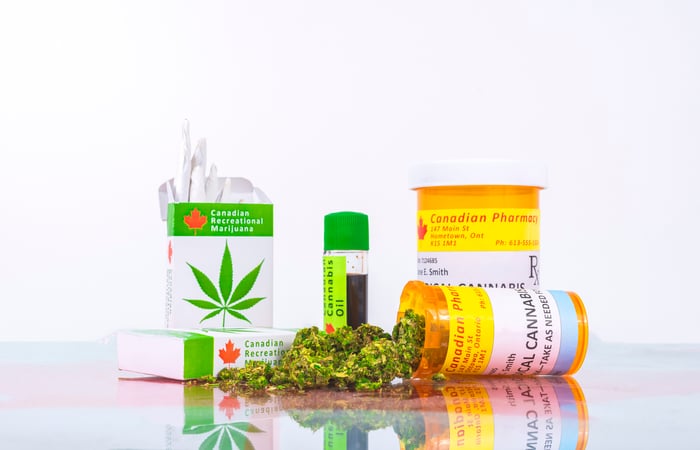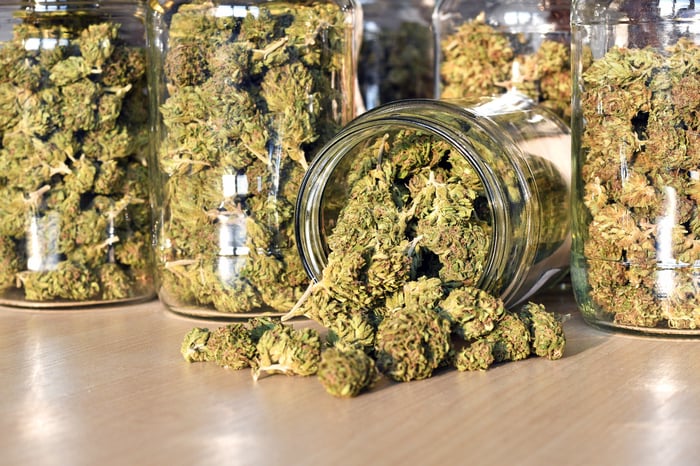This very well could be a game-changing year for the cannabis industry. In June, Canada's Senate will vote on bill C-45, more affably known as the Cannabis Act, which, if approved, could soon thereafter result in recreational marijuana sales being legal. The current timeline suggests sales could kick off in August or September.
Should Canada legalize adult-use weed, it would become the first developed country in the world to do so. It would also open the door to an additional $5 billion in annual sales, which comes on top of the medicinal sales and export revenue that growers are already realizing. As a result, growers have been expanding their production capacity as quickly as their balance sheets will allow.

Image source: Getty Images.
10 things that matter from Aphria's Q3 report
One such major player is Aphria (NASDAQOTH: APHQF). At the moment, Aphria is on track to be the third-largest producer by annual yield -- approximately 230,0000 kilograms, by its own estimate -- and it just so happens to have reported its third-quarter operating results last week. Let's take a deeper dive into Aphria by looking at the 10 things you should know following its report.
1. Demand remains strong
To begin with, sales growth remains exceptionally strong. For the third quarter, Aphria generated $8.1 million in sales, which represents 101% year-over-year growth from Q3 2017. Aphria is benefiting from a broadening base of medical patients as well as a burgeoning distribution channel that allows it to export dried cannabis to foreign markets that've legalized medicinal cannabis.
2. Economies of scale are taking shape
We're also beginning to see economies of scale lower Aphria's production costs. In other words, as the company's growing operations expand, we're seeing production costs fall. In the latest quarter, adjusted gross margin increased by 710 basis points from the previous year to 77.1%, while cash costs to produce cannabis per gram dropped to 0.96 Canadian dollars ($0.76 per gram) from the sequential second quarter. That's a 34% drop in cash costs from the previous quarter!

Image source: Getty Images.
3. Aphria is profitable, but with a catch
Aphria's management has also regularly emphasized remaining profitable, and this quarter was no different. The company delivered $10.2 million in net income, working out to CA$0.08 per share. That might seem impressive, but there was a catch involved. Aphria wound up recognizing CA$26.3 million ($20.8 million) in gains from the sale of its passive stake in Liberty Health Sciences as a result of its decision to divest its passive U.S. assets following Attorney General Jeff Sessions' rescinding on the Cole memo in January. Without this one-time gain, Aphria would have lost money in Q3 2018.
It's worth noting that this was also the 10th consecutive quarter of positive EBITDA (earnings before interest, taxes, depreciation, and amortization).
4. Organic projects are mostly on track
Aphria's production is essentially comprised of three primary components: its organic build known as Aphria One, its partnered Aphria Diamond project, and the recently acquired Broken Coast Cannabis. Aphria One, which will span 1 million square feet and yield around 100,000 kilograms annually, remains on track to produce its first sale in January 2019. Similarly, Aphria Diamond (named for its partnership with Double Diamond Farms), should produce its first sale in January 2019.
However, the recently acquired Broken Coast Cannabis has fallen a tad bit behind schedule. Aphria announced that it's modified a phase-four expansion at Broken Coast's facility and moved first sale expectations to fall 2019 from "early 2019." Of course, Broken Coast is the smallest annual producer of the three (about 10,500 kilograms a year at full capacity), so this may not be a big deal.

Image source: Getty Images.
5. Aphria is still looking for "strategic opportunities"
But don't think for a moment that Aphria is anywhere near done expanding. Aside from the fact that it has acreage it could use to build another grow facility, CEO Vic Neufeld noted in the company's third-quarter operating results press release that:
Our focus remains on exploring strategic opportunities and partnerships globally while continuing our extensive preparations for the coming legalization of the adult-use market in Canada.
In other words, don't be surprised if Aphria remains active on the acquisition front.
6. There's ample cash on hand
Then again, Aphria certainly has the capital to go shopping, should it choose to do so. The company ended the latest quarter with $94.2 million in cash and cash equivalents, as well as another $42.8 million in marketable securities, which are primarily held in the form of corporate bonds. All of Aphria's expansion projects are fully funded at this point, so it has the presumed flexibility to look for acquisitions and partnerships that could increase its production or better its distribution.
7. The Nuuvera acquisition is complete
Speaking of distribution channels, Aphria also recently completed its cash-and-stock acquisition of Nuuvera in the second-largest marijuana deal in history. Though Nuuvera isn't bringing an upgrade in production yield to the table, its distribution network opens the door -- along with a recent announcement that Aphria would be an exclusive supplier of medical cannabis in Argentina -- to one dozen markets, including Canada. Should domestic oversupply rear its head in Canada, the ability to export to foreign markets will prove critical to buoying margins.

Image source: Getty Images.
8. Inventory levels are building
With Canada apparently set to legalize recreational cannabis in a matter of months, growers are doing what they can to build up inventory ahead of the expected waving of the proverbial green flag. According to Aphria's financial statements, the company has $9.28 million in inventory, which is triple the value of product it had in inventory at this time last year. As expected, harvested cannabis makes up the bulk of Aphria's inventory, but it's worth noting that cannabis oil inventory -- a considerably higher-margin product -- almost quintupled from the prior-year quarter.
9. Dilution is a drag
But not everything is good news. As has become endemic of the industry, dilution is rearing its head for Aphria's shareholders. According to the company's 30-page financial statement filing (page 4, for those interested), the company had approximately 70 million shares outstanding for its Canadian listing as of May 31, 2016. By Feb. 28, 2017, this figure had risen to 124.1 million, and as of Feb. 28, 2018, it now stands at 177.7 million.
These extra shares are the result of five bought-deal offerings since August 2016, as well as the shares that were issued to acquire Broken Coast Cannabis. These bought-deal offerings dilute existing shareholders and can make it more difficult for companies to generate a meaningful per-share profit.
10. And it's only going to get worse
Lastly, Aphria's dilution only looks as if it'll get worse in the months and years that lie ahead. Through 2022, there are 2.3 million warrants outstanding and more than 3.7 million exercisable stock options. If Aphria goes shopping once again, there's a very good chance it'll be a cash-and-stock deal. Further, Aphria's 177.7 million outstanding shares in Canada don't account for the recently completed Nuuvera acquisition. In short, dilution could be a major deterrent for investors.




